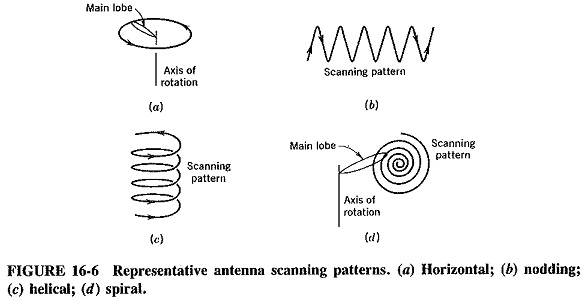Antenna Scanning Methods:
Radar antennas are often made to scan a given area of the surrounding space, but the actual scanning pattern depends on the application. Figure 16-6 shows some typical Antenna Scanning Methods.
The first of these is the simplest but has the disadvantage of scanning in the horizontal plane only. However, there are many applications for this type of scan in
searching the horizon, e.g., in ship-to-ship radar. The nodding scan of Figure 16-6b is an extension of this; the antenna is now rocked rapidly in elevation while it rotates more slowly in azimuth, and scanning in both planes is obtained.
The system can be used to scan a limited sector or else it can be extended to cover the complete hemisphere. Another system capable of search over the complete hemisphere is the helical scanning system of Figure 16-6c, in which the elevation of the antenna is raised slowly while it rotates more rapidly in azimuth.
The antenna is returned to its starting point at the completion of the scanning cycle and typical speeds are a rotation of 6 rpm accompanied by a rise rate of 20°/minute (World War II SCR-584 radar). Finally, if a limited area of more or less circular shape is to be covered, spiral scan may be used, as shown in Figure 16-6d,
